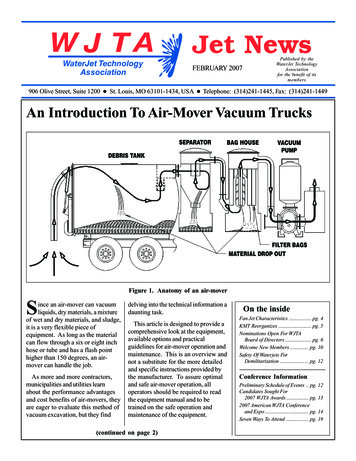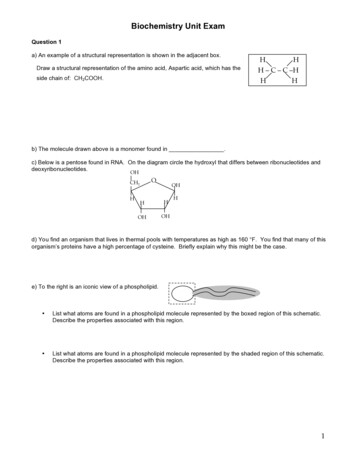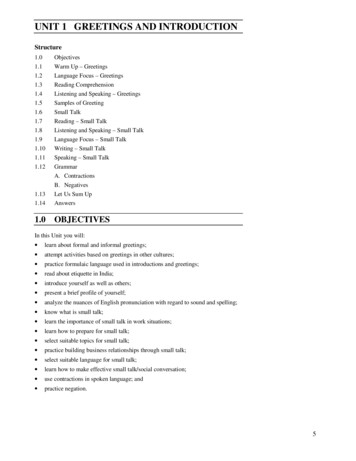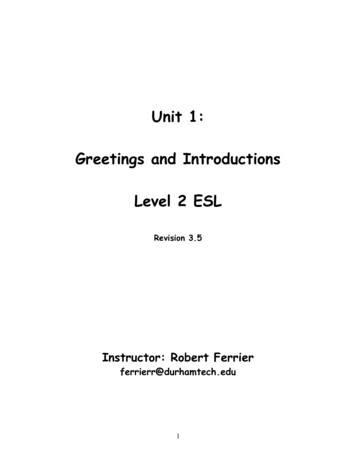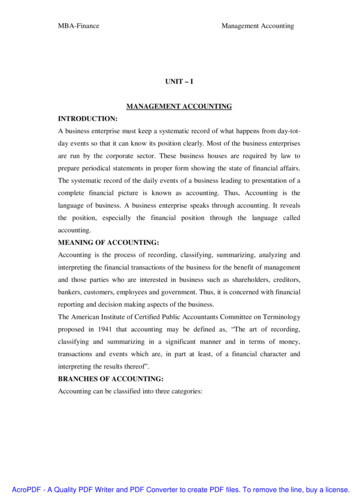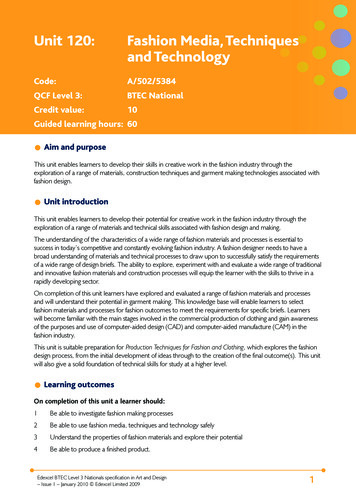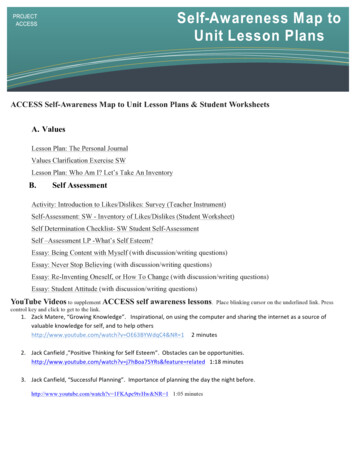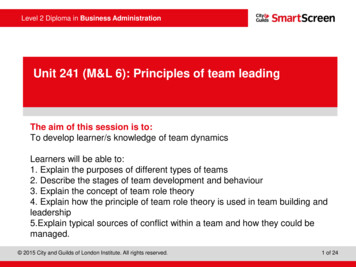
Transcription
Level 2 Diploma in Business AdministrationUnit 241 (M&L 6): Principles of team leadingPowerPointpresentationThe aim of this session is to:To develop learner/s knowledge of team dynamicsLearners will be able to:1. Explain the purposes of different types of teams2. Describe the stages of team development and behaviour3. Explain the concept of team role theory4. Explain how the principle of team role theory is used in team building andleadership5.Explain typical sources of conflict within a team and how they could bemanaged. 2015 City and Guilds of London Institute. All rights reserved.1 of 24
Level 2 Diploma in Business AdministrationDifferent teamsThere are as many as seven different types of teams butmostly they come into two categories: Permanent Temporary. 2015 City and Guilds of London Institute. All rights reserved.2 of 24
Level 2 Diploma in Business AdministrationTypes of teams FunctionalCross-functional teamsSelf-managed teamsVirtual teamsTask forcesProject teamsQuality circlesDiscuss in your groups the features of each of these teams. 2015 City and Guilds of London Institute. All rights reserved.3 of 24
Level 2 Diploma in Business AdministrationTeam types Functional team ̶ all with a common functional expertise, workingtoward shared objectives. Functional teams are traditional corporateteams often as a whole department, or with a part of it. For examplethe accounting department of a town council. Cross-functional team – a multidisciplinary group of people whosemembers hold different backgrounds, expertise and functionsworking towards shared objectives such as department store teams. Self-managed teams – a team who works autonomously (withoutsupervision) to common goals set by the organisation. Virtual teams – commonly known as a remote team that works overdifferent locations, time, space and countries, and thatcommunicates electronically. 2015 City and Guilds of London Institute. All rights reserved.4 of 24
Level 2 Diploma in Business AdministrationTeam types Task forces – A team brought together to get a single objectivecompleted. Mostly found in the uniformed forces such as army,navy, police etc. Project teams – A team assigned to activities for the same project.They can be divided into sub-teams according to need. Usuallyproject teams are only used for a defined period of time. They aredisbanded after the project is deemed complete. This is often foundin the construction industry. Quality circles – A group of workers who do the same or similarwork, who meet regularly to identify, analyse and solve work-relatedproblems. Normally small in size, the group is usually led by asupervisor. In education you may find a group of tutors, assessorsand internal verifiers getting together in a quality circle to share bestpractice. 2015 City and Guilds of London Institute. All rights reserved.5 of 24
Level 2 Diploma in Business AdministrationTypes of teamsWorksheet 5 – Different team types Work through Worksheet 5 and discuss it with your tutor. This can be used as knowledge evidence in yourportfolio. 2015 City and Guilds of London Institute. All rights reserved.6 of 24
Level 2 Diploma in Business AdministrationTeam development – Tuckman’s theory 2015 City and Guilds of London Institute. All rights reserved.7 of 24
Level 2 Diploma in Business AdministrationTuckman’s theory Forming – when the team get introduced and beginmaking judgements about each other and ground rulesare set. Storming ̶ usually when the group begin to resistleadership and demonstrate hostility to others. Norming – when the group begin to form alliances andmore harmony is established. Performing – when group works together getting theirwork done. Reforming – when the group disband and or teammembers leave and stage one begins again. 2015 City and Guilds of London Institute. All rights reserved.8 of 24
Level 2 Diploma in Business AdministrationTeam developmentIn your teams discuss when you have been at the differentstages of the Tuckman's theory and how you and othersbehave in teams. 2015 City and Guilds of London Institute. All rights reserved.9 of 24
Level 2 Diploma in Business AdministrationDevelopment activityActivity 3 – Team roles 2015 City and Guilds of London Institute. All rights reserved.10 of 24
Level 2 Diploma in Business AdministrationTeam role theory ̶ Belbin’s TheoryBelbin suggests that, by understanding your role within aparticular team, you can develop your strengths andmanage your weaknesses as a team member, and soimprove how you contribute to the team. This should createmore balance in a team.Now research the internet and takea free est 2015 City and Guilds of London Institute. All rights reserved.11 of 24
Level 2 Diploma in Business AdministrationBelbin’s nine types of team roles and how theycontribute to performanceAction-orientated roles: Shaper – they challenge, are dynamic and overcomeobstacles. They can be prone to offend and can beeasily provoked. Implementer – disciplined, reliable, conservative, turnsideas into practical actions. They can be inflexible andslow to respond to change. Completer finisher – delivers on time, conscientious,checks for errors and pays attention to detail. They canworry unduly and be reluctant to delegate. 2015 City and Guilds of London Institute. All rights reserved.12 of 24
Level 2 Diploma in Business AdministrationBelbin’s nine types of team roles and how theycontribute to performancePeople-orientated roles: Co-ordinator ̶ Mature, confident, clarifies goalsdelegates well. They can be seen as manipulative andoffloads tasks they don’t like. Team-worker – Co-operative, mild, perceptive anddiplomatic listens and keeps the peace. They can beindecisive in a crisis. Resource investigator – Extrovert, enthusiastic, goodcommunicator, explores opportunities and sharesinformation. They can be over optimistic and loseinterest quickly. 2015 City and Guilds of London Institute. All rights reserved.13 of 24
Level 2 Diploma in Business AdministrationBelbin’s nine types of team roles and how theycontribute to performanceCerebral roles: Plant – creative, imaginative, solves difficult problems.They can be prone to ignoring details and are toopreoccupied to communicate well. Monitor evaluator – strategic, sees all opinions and isaccurate. They tend to lack drive or the ability to inspire. Specialist – single-minded, self-starter, dedicated andbrings knowledge. They are prone to only working withinnarrow parameters and dwells on technicalities. 2015 City and Guilds of London Institute. All rights reserved.14 of 24
Level 2 Diploma in Business AdministrationConcept of team behavioursBelbin’s theory is a tool for leaders to help them recognisethe diversity in their teams. 2015 City and Guilds of London Institute. All rights reserved.15 of 24
Level 2 Diploma in Business AdministrationTeam roles and how to build a teamWorksheet 6 – Describe team roles Work through Worksheet 6 and discuss it with your tutor. This can be used as knowledge evidence in yourportfolio. 2015 City and Guilds of London Institute. All rights reserved.16 of 24
Level 2 Diploma in Business AdministrationConflict in the workplaceWhat causes conflict in the workplace? 2015 City and Guilds of London Institute. All rights reserved.17 of 24
Level 2 Diploma in Business AdministrationSources of conflict within a teamThere are many sources of conflict and these are eight ofthe most frequent: Internal change External changes Relationships Hierarchy Poor performers Poor communication Limited resources Harassment. 2015 City and Guilds of London Institute. All rights reserved.18 of 24
Level 2 Diploma in Business AdministrationConflict within a teamWhy is managing conflict important? 2015 City and Guilds of London Institute. All rights reserved.19 of 24
Level 2 Diploma in Business AdministrationWhy manage conflict within a team? Maintain morale Maintain performance standards Minimise absenteeism Promote a safe working environment Maintain group co-operationThe use of the organisation’s formal processes forconsultation, intervention or even discipline can beused to resolve conflict. 2015 City and Guilds of London Institute. All rights reserved.20 of 24
Level 2 Diploma in Business AdministrationTypes of conflict techniques/resolutionPositive solutions/outcomes: Win-Win (collaborating)Attempting to identify the underlying concerns inorder to find an alternative that satisfies everyone. CompromiseWorking to a mutually acceptable solution thatpartially satisfies everyone. 2015 City and Guilds of London Institute. All rights reserved.21 of 24
Level 2 Diploma in Business AdministrationTypes of conflict techniques/resolutionNegative solutions: ForcingUsing formal authority or coercion to get one’s own wayat the expense of others. AvoidingNot addressing the conflict, withdrawing from athreatening situation. AccommodatingNeglecting own concerns to satisfy others. 2015 City and Guilds of London Institute. All rights reserved.22 of 24
Level 2 Diploma in Business AdministrationWorksheet 7Worksheet 7 – Why conflict occurs and how to deal with it Work through Worksheet 4 and discuss it with yourtutor. This can be used as knowledge evidence in yourportfolio. 2015 City and Guilds of London Institute. All rights reserved.23 of 24
Level 2 Diploma in Business AdministrationEnd of sessionAny questions? 2015 City and Guilds of London Institute. All rights reserved.24 of 24
Level 2 Diploma in Business Administration 2015 City and Guilds of London Institute. All rights reserved. 2 of 24 Different teams There are as many as seven .
